The roads I take...
KaiRo's weBlog
| Zeige die letzten Beiträge mit "MaKey MaKey" gekennzeichnet an. Zurück zu allen aktuellen Beiträgen | |||||||||||||||||||||||||||||||||||||||||||
12. Mai 2014
Hacking Day And Linuxwochen
In the last weeks, I spent some time on developer events, which I always embrace a lot because the "hallway tracks" are a constant great flow of interesting information and discussions - and of course the official talks are often quite interesting as well! 
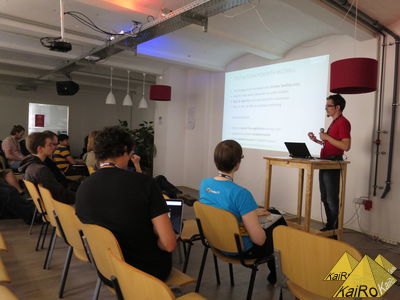
First up was the Mozilla Hacking Day in Berlin on Saturday, April 26. I met Arpad Borsos, fellow Mozillian from Vienna, already at Vienna airport on Friday, as we incidentally were hopping over from the Austrian to the German capital in the same plane. Later in Berlin, we met more Mozillians at the hotel and went out for dinner together.
At the actual Hacking Day, we had ~70 people streaming in for some introductory talks, and then people split up into hacking sessions and some more in-depth talks (like the one in the picture, where fellow "Desktop QA" team member Henrik talked about automated testing), which were followed by even more hands-on hacking. I spent most of the time talking to various people about different topics, showing off Firefox OS a bit (after I had reflashed my Geeksphone Peak and got it into a working stage again during the talks) and my actual "hacking" achievement: Together with Georg Fritzsche, we could find out that an issue with my Lantea Maps app freezing was a WebGL-related bug in Gecko, found a stack, reported it as a new bug and set a needinfo flag to a gfx developer. (Yesterday, I found a hacky workaround so Lantea Maps will soon work again despite that bug.)
On Sunday, I also was able to squeeze in some sightseeing and photo-taking, marching through Berlin for ~3.5h before returning to the airport.
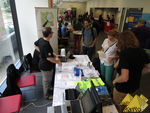
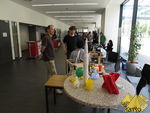
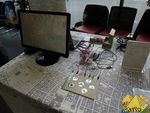
And last week, May 8-10, it was time for the yearly Linuxwochen conference in Vienna. As we do not have an organized group of Mozillians here, we didn't have a Mozilla booth, but I usually share the OpenStreetMap booth (that's why you'll spot that in the pictures), as I'm pretty active in the local community there, and just run around with Mozilla T-shirts and talk about Mozilla stuff in addition to OSM things. I also had submitted talks about Firefox OS and the Makey Makey, but as you'll see in my speaker profile, I was additionally "coerced" into a privacy and security panel discussion last-minute as well. I was put there as more or less a representative of Mozilla and more in general those doing end-user software, and of course also tried to drum home a few points of how Mozilla strongly works for respecting user privacy but also pointed out how it is an interesting field that sometimes has tradeoffs with enabling features that people out there really want, and finding a balance can be hard.
The Firefox OS talk was quite appreciated by people attending, and we had quite a few good questions asked there as well, and interest from people afterwards to actually see and try my FxOS phones - I remember how some hard a hard time believing how well the ZTE Open worked with just 256MB of RAM and an all-web UI.
In the "hallway track", I did get a lot of questions about Mozilla on all three days, given my T-shirts clearly pointed out my affiliation with the project. Some of those were Firefox OS, mostly about strategy and availability, where I had to explain a few times how we target features phone converts in emerging markets for now. A number of the concerns and questions were around Australis, with quite a few of the very technical folks there not liking how we messed up their customizations and preferences, including tops-on-bottom or the add-ons bar, or how esp. our tabs looked "just like Chrome" now, but I even heard one or two comments on how awesome the new design was. Some of those I could ease with explanation and pointing to the Classic Theme Restorer add-on, but some of them are just unhappy (and it's not helpful that the very helpful Tour does not run when NoScript is installed and active). And then there were questions about our finances (the "Google dependency" issue) and about the fact that new Sync clashes with Master Password (which also protects casual "friends" from reading through passwords in your password manager), among others. Overall, a lot of talk about Mozilla, and I hope I could make most of those people feel better about us than before, wherever they stood then.
Both events cost me a lot of sleep and energy right there, but feel like they were worth the investment for sure, and the meeting and talking to people also gives me energy of a different form.
First up was the Mozilla Hacking Day in Berlin on Saturday, April 26. I met Arpad Borsos, fellow Mozillian from Vienna, already at Vienna airport on Friday, as we incidentally were hopping over from the Austrian to the German capital in the same plane. Later in Berlin, we met more Mozillians at the hotel and went out for dinner together.
At the actual Hacking Day, we had ~70 people streaming in for some introductory talks, and then people split up into hacking sessions and some more in-depth talks (like the one in the picture, where fellow "Desktop QA" team member Henrik talked about automated testing), which were followed by even more hands-on hacking. I spent most of the time talking to various people about different topics, showing off Firefox OS a bit (after I had reflashed my Geeksphone Peak and got it into a working stage again during the talks) and my actual "hacking" achievement: Together with Georg Fritzsche, we could find out that an issue with my Lantea Maps app freezing was a WebGL-related bug in Gecko, found a stack, reported it as a new bug and set a needinfo flag to a gfx developer. (Yesterday, I found a hacky workaround so Lantea Maps will soon work again despite that bug.)
On Sunday, I also was able to squeeze in some sightseeing and photo-taking, marching through Berlin for ~3.5h before returning to the airport.
And last week, May 8-10, it was time for the yearly Linuxwochen conference in Vienna. As we do not have an organized group of Mozillians here, we didn't have a Mozilla booth, but I usually share the OpenStreetMap booth (that's why you'll spot that in the pictures), as I'm pretty active in the local community there, and just run around with Mozilla T-shirts and talk about Mozilla stuff in addition to OSM things. I also had submitted talks about Firefox OS and the Makey Makey, but as you'll see in my speaker profile, I was additionally "coerced" into a privacy and security panel discussion last-minute as well. I was put there as more or less a representative of Mozilla and more in general those doing end-user software, and of course also tried to drum home a few points of how Mozilla strongly works for respecting user privacy but also pointed out how it is an interesting field that sometimes has tradeoffs with enabling features that people out there really want, and finding a balance can be hard.
The Firefox OS talk was quite appreciated by people attending, and we had quite a few good questions asked there as well, and interest from people afterwards to actually see and try my FxOS phones - I remember how some hard a hard time believing how well the ZTE Open worked with just 256MB of RAM and an all-web UI.
In the "hallway track", I did get a lot of questions about Mozilla on all three days, given my T-shirts clearly pointed out my affiliation with the project. Some of those were Firefox OS, mostly about strategy and availability, where I had to explain a few times how we target features phone converts in emerging markets for now. A number of the concerns and questions were around Australis, with quite a few of the very technical folks there not liking how we messed up their customizations and preferences, including tops-on-bottom or the add-ons bar, or how esp. our tabs looked "just like Chrome" now, but I even heard one or two comments on how awesome the new design was. Some of those I could ease with explanation and pointing to the Classic Theme Restorer add-on, but some of them are just unhappy (and it's not helpful that the very helpful Tour does not run when NoScript is installed and active). And then there were questions about our finances (the "Google dependency" issue) and about the fact that new Sync clashes with Master Password (which also protects casual "friends" from reading through passwords in your password manager), among others. Overall, a lot of talk about Mozilla, and I hope I could make most of those people feel better about us than before, wherever they stood then.
Both events cost me a lot of sleep and energy right there, but feel like they were worth the investment for sure, and the meeting and talking to people also gives me energy of a different form.
Von KaiRo, um 18:42 | Tags: Lantea, Linuxwochen, MaKey MaKey, Mozilla, OSM | keine Kommentare | TrackBack: 0
24. März 2013
MaKey MaKey Experiments
I think I probably became aware of the MaKey MaKey when Chris Heilmann blogged about it, but I might have heard about it even before. I surely saw it when Chris had his WebRTC photo booth running with it at MozFest 2012 in London.
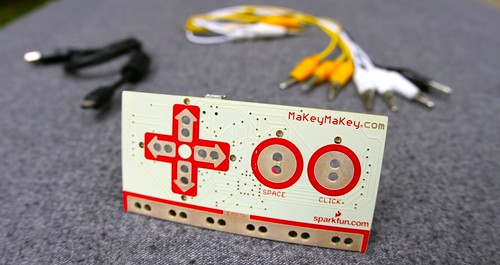
When I ran across it again on ThinkGeek, I put it on my wish list - and finally ordered one this month. Now, after I had wrapped up this week of work, I finally found some time to play with it, and an interesting and very geeky Friday night ensued. Here's a bit more about that - and about Saturday, and further plans/ideas.
So, for one thing, I wanted to use this device with actual Open Web stuff, and not with Flash or other proprietary software. After all, this is Open Hardware (yay!) and I'm entirely entrenched in Open Source / Free Software, from using Linux on desktop, laptop and server, via working for Mozilla/Firefox, to doing some web apps under the MPL2 license in my free time. So, given the latter, I decided it would be nice if I could navigate the OSM world with my Lantea Maps app/site (source) using the MaKey Makey. For that, I had to put some keyboard accessibility into Lantea Maps itself, which is a good idea for accessibility, among other things, anyhow. So I did that, looking at Chris' testy-testy and MDN to find out how to achieve that best. I ended up implementing methods to move the map with the arrow keys, hooked up zoom in/out to +/- keys as well as w/s (the latter are supported by MaKey MaKey out of the box), and then also created direct shortcuts to certain zoom levels with the 0-9 numeric keys (not supported by MaKey Makey, but convenient for keyboard users).
OK, then it was time to actually bring in the MaKey MaKey. I really want to do some fruit stuff at some point, but I only had a few apples around, and I thought it actually would be nice to create some kind of navigation pad that can be used with Lantea Maps at full screen when having an OpenStreetMap booth at Linuxwochen in Vienna. I figured that with some cardboard from the back of an old note pad, and some tinfoil, that should be doable. I added some plastic wrap for insulation, glue of course, and some paper clips so the crocodile clips to connect to the MaKey MaKey wouldn't scratch the tinfoil too much (as well as some temporary applied ones to hold things together while allowing the glue to dry). Here's some photos from production:
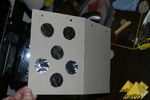
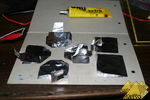
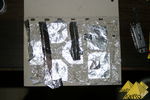
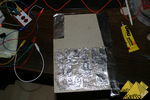
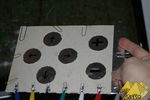
Note that the back side as well as the right rim of the pad is covered with a single sheet of tinfoil that makes the earth connection quite naturally when you hold the pad in your hands.
As of the last photo, while the glue was still drying, it was ready to use for some map navigation (and after the night, I removed the temporary paper clips and took another "promotional" picture):
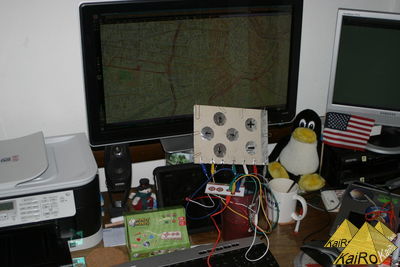
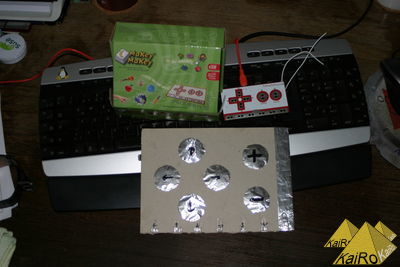
Even while getting to bed that evening, the ideas for my next project were flying around in my mind already. On one hand, I saw that MaKey MaKey had connectors for mouse up/down/left/right, on the other hand, ever since trying the original BananaBread demo as someone who's usually not doing any first person shooter games, I wondered if there was a nicer or more obvious way to operate this, rather than using w/a/s/d keys for movement, space/click for jump/fire, and mouse for turning. Well, now that I had done this first custom pad for MaKey MaKey, would there be a handy solution for that as well? In any case, it would be fun. So I took a smaller piece of cardboard that would make this thing fit nicely into my hands (just like those professional game pads), and decided this time I would try something slightly different by using coins as the actual "buttons" on the pad. One-cent coins looked like the right size, and I had a 10-pin cable around from a different project, which would fit for the 10 "keys" pretty well (just that I needed one more for earthing, which I again did with a sheet of tinfoil at the back of the pad, so I added yet another single cable in the end). Also, this time I used some double-sided tape instead of glue for many cases, as that works better with the cable and coins:


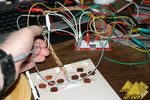
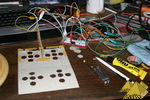
And then I was ready to play some BananaBread, now with both the awesomeness of running a 3D first person shooter seamlessly in the browser AND using a special game pad for playing!
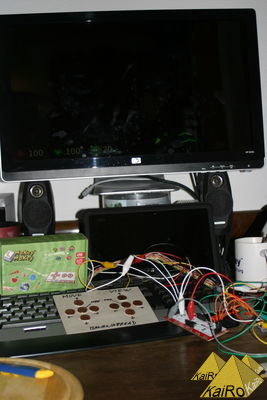
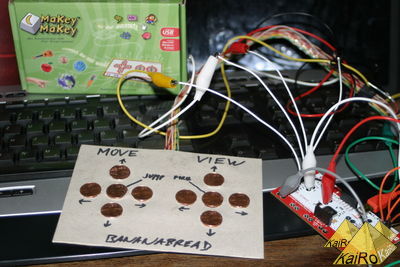
If you're interested, not only are those pictures all linked to the gallery where you can go up to "big" versions of those, there's a few more steps of building visible in this photo gallery.
Given all that and the fact that Linuxwochen Wien in the first days of May has an additional focus on Open Hardware this year, I decided to hand in a proposal for a talk on MaKey MaKey there. I intend to show off those pads as well as Chris' photo booth and any other MaKey MaKey experiments that I can fit, preferably ones that run as web pages/apps (let me know if there are any nice ones).
I'm thinking that it could be nice to have an app that shows you on screen in a web site which kind of fruit/item you touched (configurable with key <-> item entries), and I'd love a web (not Flash) piano and/or drumset (using ogg or even opus files with HTML5 audio!) app to present, maybe I can hack something up if there's nothing around.
If this has caught your interest, it's easy to get your own MaKey MaKey, and if you're in or around Vienna in the first days of May, I'd be happy to meet you at my talk (there will be a Firefox OS App workshop as well, probably!) - oh, and if you have any nice, open web apps/pages that show off this device, let me know!
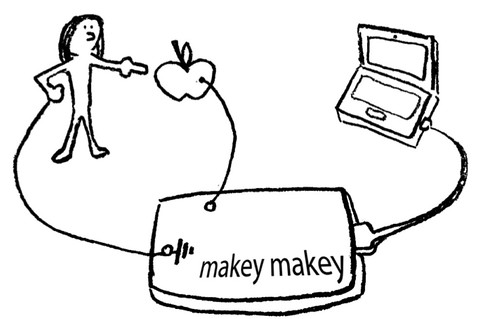

When I ran across it again on ThinkGeek, I put it on my wish list - and finally ordered one this month. Now, after I had wrapped up this week of work, I finally found some time to play with it, and an interesting and very geeky Friday night ensued. Here's a bit more about that - and about Saturday, and further plans/ideas.
So, for one thing, I wanted to use this device with actual Open Web stuff, and not with Flash or other proprietary software. After all, this is Open Hardware (yay!) and I'm entirely entrenched in Open Source / Free Software, from using Linux on desktop, laptop and server, via working for Mozilla/Firefox, to doing some web apps under the MPL2 license in my free time. So, given the latter, I decided it would be nice if I could navigate the OSM world with my Lantea Maps app/site (source) using the MaKey Makey. For that, I had to put some keyboard accessibility into Lantea Maps itself, which is a good idea for accessibility, among other things, anyhow. So I did that, looking at Chris' testy-testy and MDN to find out how to achieve that best. I ended up implementing methods to move the map with the arrow keys, hooked up zoom in/out to +/- keys as well as w/s (the latter are supported by MaKey MaKey out of the box), and then also created direct shortcuts to certain zoom levels with the 0-9 numeric keys (not supported by MaKey Makey, but convenient for keyboard users).
OK, then it was time to actually bring in the MaKey MaKey. I really want to do some fruit stuff at some point, but I only had a few apples around, and I thought it actually would be nice to create some kind of navigation pad that can be used with Lantea Maps at full screen when having an OpenStreetMap booth at Linuxwochen in Vienna. I figured that with some cardboard from the back of an old note pad, and some tinfoil, that should be doable. I added some plastic wrap for insulation, glue of course, and some paper clips so the crocodile clips to connect to the MaKey MaKey wouldn't scratch the tinfoil too much (as well as some temporary applied ones to hold things together while allowing the glue to dry). Here's some photos from production:
Note that the back side as well as the right rim of the pad is covered with a single sheet of tinfoil that makes the earth connection quite naturally when you hold the pad in your hands.
As of the last photo, while the glue was still drying, it was ready to use for some map navigation (and after the night, I removed the temporary paper clips and took another "promotional" picture):
Even while getting to bed that evening, the ideas for my next project were flying around in my mind already. On one hand, I saw that MaKey MaKey had connectors for mouse up/down/left/right, on the other hand, ever since trying the original BananaBread demo as someone who's usually not doing any first person shooter games, I wondered if there was a nicer or more obvious way to operate this, rather than using w/a/s/d keys for movement, space/click for jump/fire, and mouse for turning. Well, now that I had done this first custom pad for MaKey MaKey, would there be a handy solution for that as well? In any case, it would be fun. So I took a smaller piece of cardboard that would make this thing fit nicely into my hands (just like those professional game pads), and decided this time I would try something slightly different by using coins as the actual "buttons" on the pad. One-cent coins looked like the right size, and I had a 10-pin cable around from a different project, which would fit for the 10 "keys" pretty well (just that I needed one more for earthing, which I again did with a sheet of tinfoil at the back of the pad, so I added yet another single cable in the end). Also, this time I used some double-sided tape instead of glue for many cases, as that works better with the cable and coins:
And then I was ready to play some BananaBread, now with both the awesomeness of running a 3D first person shooter seamlessly in the browser AND using a special game pad for playing!
If you're interested, not only are those pictures all linked to the gallery where you can go up to "big" versions of those, there's a few more steps of building visible in this photo gallery.
Given all that and the fact that Linuxwochen Wien in the first days of May has an additional focus on Open Hardware this year, I decided to hand in a proposal for a talk on MaKey MaKey there. I intend to show off those pads as well as Chris' photo booth and any other MaKey MaKey experiments that I can fit, preferably ones that run as web pages/apps (let me know if there are any nice ones).
I'm thinking that it could be nice to have an app that shows you on screen in a web site which kind of fruit/item you touched (configurable with key <-> item entries), and I'd love a web (not Flash) piano and/or drumset (using ogg or even opus files with HTML5 audio!) app to present, maybe I can hack something up if there's nothing around.
If this has caught your interest, it's easy to get your own MaKey MaKey, and if you're in or around Vienna in the first days of May, I'd be happy to meet you at my talk (there will be a Firefox OS App workshop as well, probably!) - oh, and if you have any nice, open web apps/pages that show off this device, let me know!

Von KaiRo, um 20:25 | Tags: BananaBread, Lantea, Lantea Maps, Linuxwochen, MaKey MaKey, Open Hardware, OSM | keine Kommentare | TrackBack: 1
